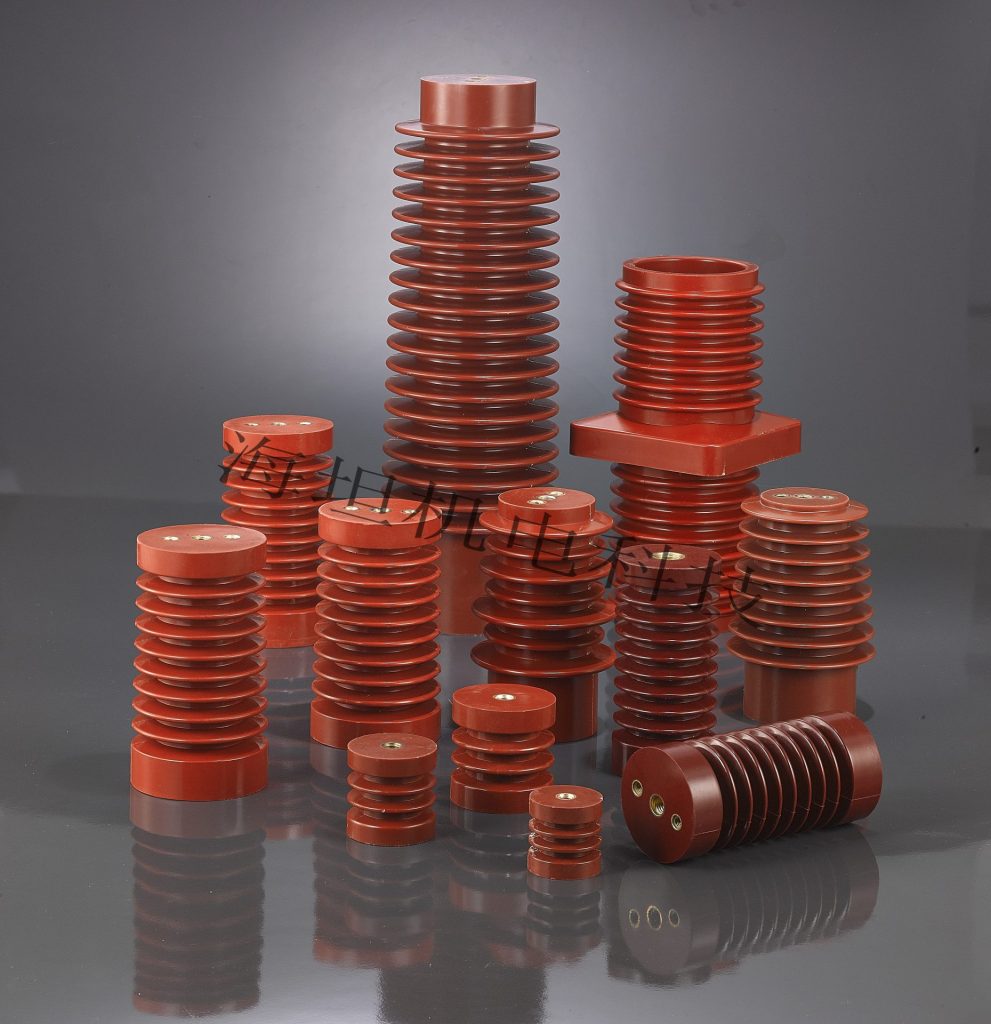Busbar Insulator Maintain and Manage
1. What Is a Busbar Insulator and Why Is It Important?
A busbar insulator is a critical component in power distribution systems. It is typically made of copper or aluminum and used to support and electrically isolate conductive busbars. These insulators prevent electrical faults like short circuits, arcing, and leakage by separating live conductors and grounded metal parts safely.
Common materials include epoxy resin, porcelain, and composite polymers, chosen for their high dielectric strength and durability. Designs vary—cylindrical, conical, or flanged—based on voltage level, environmental exposure, and mechanical stress.
Busbar insulators serve dual functions: ensuring electrical insulation and providing mechanical stability in switchgear, control cabinets, and panel boards. They’re engineered to perform reliably under heat, humidity, vibration, and corrosive conditions.
Proper maintenance and selection of high-quality insulators are essential for system safety, especially in applications like low-voltage switchboards, UPS enclosures, and industrial busducts. Neglecting this can lead to premature failure or operational downtime.
This guide offers practical steps for inspecting, testing, and protecting busbar insulators to extend service life and minimize electrical hazards.
2. Busbar Insulators Regular Inspection
Regular inspection is very necessary. Through inspection, problems can be found and dealt with in time. In this step, we can use routine visual inspection to see whether the overall appearance of the insulator is good and whether the position of the insulator and the busbar is correct. If the appearance of the busbar insulator is found to be cracked, deformed, or aged during the inspection, we should replace it in time to ensure that it can provide good insulation and support for the busbar. At the same time, the loose connection between the busbar and the insulator can be reinforced to ensure that the busbar insulator has good contact with the busbar and provides efficient insulation.
3. Busbar Insulators Electrical Performance Testing
Electrical integrity is one of the most critical performance indicators for any busbar insulator. Its primary role is to prevent unwanted current flow between the busbar and surrounding conductive structures, which can otherwise lead to arcing, equipment damage, or system failure.
Standard Testing Techniques
The most common method to assess insulation effectiveness is through insulation resistance testing, typically performed using a Megger (insulation tester). This test measures the insulator’s resistance to leakage current:
- For low-voltage systems (up to 1000V), use a 500V DC Megger, with a minimum acceptable resistance typically ≥ 100 MΩ.
- For medium- to high-voltage systems, a 2500V or 5kV Megger is used, and resistance should exceed ≥ 1000 MΩ.
These resistance benchmarks align with IEC 61439 for switchgear assemblies and ANSI/IEEE C37.23 for metal-enclosed bus configurations.
Tip: Always clean the surface of the busbar support insulator before testing to remove dust or moisture that could distort readings.
Key Diagnostic Insights
A drop in insulation resistance may indicate:
- Thermal aging or UV degradation in epoxy or polymer-based insulators
- Surface contamination from salt, dust, or moisture, especially in coastal or industrial environments
- Internal voids or cracks, which can lead to partial discharge
- Mechanical stress or improper mounting, leading to dielectric breakdown over time
Advanced testing setups may include:
- Polarization Index (PI) testing, comparing 1-minute and 10-minute resistance readings to assess insulation aging
- Temperature-corrected resistance measurements, ensuring test results reflect real-world conditions
Best Practices for Electrical Testing
- Disconnect and isolate the busbar circuit.
- Clean the insulator’s surface and terminal contact points.
- Connect the Megger leads between the busbar and ground.
- Apply voltage for at least 60 seconds and record the resistance.
- Log the data for trend analysis.
Beyond Resistance: Partial Discharge and Dielectric Testing
While Megger testing verifies surface-level insulation, Partial Discharge (PD) testing identifies microscopic internal voids or defects. PD tests are vital in laminated or multilayer busbars used in renewable power systems, EV chargers, and high-efficiency inverter cabinets.
Additionally, Hi-Pot (High Potential) testing involves applying a high voltage—usually 2x operating voltage plus 1kV—to validate dielectric integrity across insulation barriers. For example:
- A 480V system may require a Hi-Pot test at 1960V DC (480V × 2 + 1000V)
A well-performing busbar insulation block should exhibit no breakdown or abnormal leakage current.
4. Busbar Insulators Connection Inspection
The stability of the busbar insulator can ensure good insulation between the busbar and other electrical components and guarantee the operation of the system. Therefore, we should regularly check the fixation of the busbar insulator and the connection with the busbar, and check whether the busbar insulator and the bracket are loose, moved, or corroded. If any problems are found, they need to be dealt with in time, reinforced, or cleaned to ensure that the busbar insulator can perform at its best.
5. Busbar Insulators Anti-corrosion protection
The anti-corrosion protection of busbar insulators is very important, especially in high-temperature, high-pressure, or harsh environments. Busbar insulators may be easily corroded by the environment over time, thus affecting their insulation performance. Therefore, it is necessary to regularly inspect and protect the busbar insulators from corrosion. This is the key factor to ensure that it can stably exert its insulation performance. Therefore, if dirt or dust is found on the surface of the insulator during inspection, it needs to be cleaned up in time. For those that have part of the surface peeling off or the anti-corrosion layer is damaged, the anti-corrosion layer should be re-applied in time, or a new busbar insulator should be replaced.
6. Busbar Insulators: Temperature monitoring
According to the following mathematical formula for the relationship between temperature and resistance, which is widely used in physical science and material science (R_T0 taking 100MΩ, e is the base of the natural logarithm), we calculated the changes of busbar insulators with temperature:
| Temperature coefficient of insulating material(β) | Temperature(℃) | R_T Resistance Value(MΩ) |
| 0.04 | 20 | 100 |
| 25 | 81.8 | |
| 30 | 67.0 | |
| 35 | 54.8 | |
| 40 | 44.9 |
It can be seen that the insulation performance of busbar insulators will decrease with the increase in temperature. When the temperature increases by 10℃, the insulation resistance value decreases by 32.9%. When the temperature increases by 20℃, the insulation resistance value decreases by 55.1%. Therefore, we must regularly use infrared thermometers or other thermometers to monitor the temperature of busbar insulators, especially in high current load systems, to avoid overheating of insulators, causing aging of insulators and reducing their insulation performance. If the temperature of busbar insulators is found to be too high, emergency measures such as reducing their load, checking whether their contact points are good, and improving cooling can be taken to ensure the safety and stability of the system.
7. Busbar Insulators Cleaning and replacement
Keeping the surface of the busbar insulator clean can extend its service life and stabilize its performance. As time goes by, the busbar insulator will be contaminated by dust, salt or other pollutants in the environment, so it is necessary to clean the low-voltage insulator blocks regularly. You can use a clean rag or a small brush with a professional detergent to clean it. Avoid using corrosive detergents or detergents that can damage the surface coating of the insulator. For insulators that cannot be cleaned and affect the insulation performance, we need to replace them, so that the busbar insulator can perform at its best and protect the safety of the busbar and other electrical components.
8. Documentation
Archiving each maintenance record is crucial for long-term operation management, providing necessary records and data support, and providing practical knowledge for subsequent training and education. Therefore, it is necessary to ensure that after each maintenance, the maintenance parts, problems found, rectification measures, and responsible persons are recorded in detail according to the corresponding standards.
9. Training and education
Technicians should receive ongoing training on busbar system architecture, the identification of aging signs in insulators, correct use of test instruments (e.g. insulation resistance testers, thermal imagers), and safety standards such as IEC 61439. Regular upskilling supports safe installation, reliable diagnostics, and faster failure resolution.
10. Smart Monitoring of Busbar Insulators
Advanced systems now offer real-time monitoring for critical electrical insulators using embedded sensors or IoT devices. These modules track:
- Surface temperature
- Leakage current
- Humidity or dust accumulation
By integrating such data into a SCADA or EMS platform, facility engineers can anticipate insulation failure before faults occur. Smart monitoring improves asset lifespan and safety in data centers, battery storage systems, and high-efficiency switchboards.
Conclusion
A busbar insulator is not just a passive part—it is a critical safety and performance element in all power distribution systems. From modular switchboards to busbar trunking, their performance must be consistently monitored and maintained.
Through regular inspections, temperature management, proper documentation, and professional training, you can significantly extend the lifespan and reliability of your busbar insulation components. Implementing smart monitoring and IEC-standard testing is the next step toward intelligent, failure-free power systems.
FAQS
Q: What is a busbar insulator?
A: A busbar insulator is an insulating device used to support and fix the busbar, which plays the role of electrical isolation and preventing line short circuit.
Q: How often should busbar insulators be maintained?
A: Generally, we recommend inspection and maintenance every three to six months. If the environment is particularly harsh, the inspection frequency should be increased to ensure the stable performance of the busbar insulator.
Q: What are the materials of busbar insulators?
A: The materials of busbar insulators are generally ceramic, glass, epoxy resin, polymer (composite material), etc.
--- END ---
© Copyright 2024 China Haitan Electromechanical Technology Co., Ltd. All rights reserved.SUPPORT BY:JUNJ Privacy Policy




